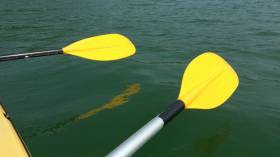Displaying items by tag: East Belfast
Northern Ireland Canoeist Alistair McCreery Awarded Bursary
Alistair McCreery, a 24-year-old canoeist from East Belfast, is the sixth athlete to have been awarded a £500 bursary as part of the ongoing Hughes Insurance partnership with the Mary Peters Trust.
The £5,000 bursary programme is now in its second year and awards funding to ten young athletes from across Northern Ireland to support them on their sporting journey. Each of the ten athletes are selected by the Mary Peters Trust.
Alistair has been representing Ireland in canoe slalom since 2015. The sport calls on competitors to navigate a decked canoe or kayak through a course of downstream or upstream gates on river rapids in the fastest time possible.
 Alistair McCreery the 24 year old Irish Canoeist
Alistair McCreery the 24 year old Irish Canoeist
Lady Mary Peters said: “Alistair has achieved so much already including progressing to the semi-finals at two ICF canoe slalom world cups. He is a fantastic ambassador for Northern Ireland and an inspiration to other young athletes.”
Inspired by the uniqueness of slalom canoeing, Alistair took up the sport in 2009 at the tender age of thirteen. He quickly progressed and has gone on to compete internationally, including at the World Championships in Augsburg this past July with 8000 spectators looking on.
This year marks 50 years since canoe slalom was first introduced to the Olympic program in Munich 1972, significant given that too is the year Lady Mary Peters brought home gold.
Commenting on his bursary, Alistair said: “It is an honour to be given this award and to become part of a group of athletes who have received awards and support from Lady Mary’s Trust over the years, such as Rory McIlroy and Paddy Barnes".
“Over the years, I have developed so much love for my sport. I enjoy how different it is. It’s fair to say that canoeing has not only changed my life but become my life, and it’s been my vehicle to see the world taking me to Brazil, all over Europe and even India. It has allowed me to become part of a community of athletes around the globe and experience things that very few people get to.”
Alistair plans to use the bursary to access training at world-class facilities in Europe ahead of the 2023 season.
Alistair added: “For the remainder of 2022, I will be focusing on preparing for the year ahead, to qualify for and compete in the 2023 European games in Krakow and the 2024 Olympic qualifiers in London. The bursary will be a huge help in accessing the training I need to be at my very best and continue to do Northern Ireland proud.”
Dispute Over Kayaking School In East Belfast
#Kayaking - A Northern Irish businessman has spoken out over what he claims is lack of support from the Alliance Party for an indoor kayaking facility in East Belfast.
As the Belfast Telegraph reports, jewellery retail entrepreneur Peter Boyle says he expects a refusal of his application to retain a marquee at a restored 50-yard pool in the grounds of Ormiston House, currently being used by the Belfast Kayaking Academy.
Boyle claims that Alliance Party leader and MLA Chris Lyttle took concerns from a local group objecting to the kayaking facility directly to the planning officer.
“We were a bit annoyed that Alliance hadn’t spoken to us first,” he told the Telegraph. “While there was a group of local people objecting, there was also significant local support.”
Boyle adds that his ire was raise by a subsequent Alliance newsletter that pledged support for sport in East Belfast.
“Our point was that this pool was meant to be a community facility and should be within the community it serves,” he said.
A solicitor for the Alliance Party has however branded Boyle’s claims as “spurious, innacurate, bizzae [and] false”, listing a number of planning enforcement cases against Boyle over alleged unauthorised works on the grounds of Ormiston House.
The Belfast Telegraph has much more on the story HERE.





























































